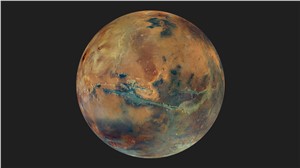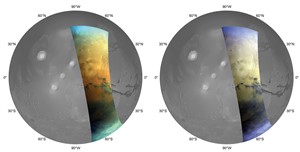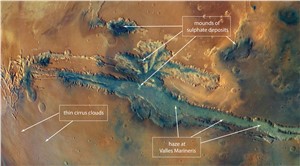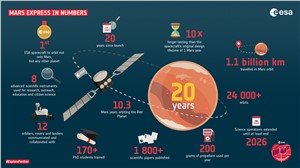



A new mosaic of Mars marks 20 years since the launch of ESA's Mars Express, and reveals the planet’s colour and composition in spectacular detail.
The mosaic was created using data from Mars Express’s High Resolution Stereo Camera (HRSC).
HRSC normally photographs Mars’s surface from an altitude of about 300 km – the closest the spacecraft gets to Mars in its elliptical orbit – with the resulting images covering areas about 50 km across. However, the mosaic presented here uses a slightly different approach. To view the planet more widely, HRSC gathered 90 images at higher altitudes (of 4000 to 10 000 km), thus capturing areas of around 2500 km wide. These images were then put together to form a full global view.

By Orbit Type (LEO, MEO, GEO, Others), by Architecture (Transparent Payload, Regenerative Payload), by Service Type (Fixed Satellite Service, Mobile Satellite Service, Broadband Satellite Service, Others), by End-User (Telecommunication, Government, Defense, Aviation, Others) and Region, with Forecasts from 2025 to 2034
Download free sample pagesSuch large-scale images are typically obtained to observe weather patterns on Mars – but even in the absence of atmospheric phenomena they offer wonderful views of the planet’s surface.
A richer colour view
This new view highlights variation across Mars’s surface by enhancing local colour and contrast.
Thanks to its nine imaging channels, HRSC can visualise Mars not only in three dimensions but also in colour. However, the ever-changing opacity of the martian atmosphere makes it difficult to determine accurate surface colours from orbit. Dust scatters and reflects light, causing colours to shift between images and creating a patchwork-like effect when assembling a mosaic.
Until now, suppressing this effect during image processing has reduced variations in colour between different parts of Mars. But to create this mosaic, the HRSC team instead colour-referenced each constituent image to a colour model derived from high-altitude observations, allowing them to preserve colour variations and reveal a far richer colour view of Mars than has been seen before.
Each colour a different material
While beautiful in its own right, the mosaic also provides fascinating information about Mars’s composition, revealing an unprecedented variety and detail of colours across its surface.
Mars is famous for its reddish colour, which is caused by high levels of oxidised iron. However, large parts of the planet appear to be rather dark and blue-toned here. These are grey-black basaltic sands of volcanic origin that form far-reaching, dark layers of sand across Mars. They pile up as they move in the wind, creating imposing sand dunes and dune fields within impact craters.
Material weathered by water, on the other hand, tends to look lighter. The two most common water-weathered minerals on Mars, clay and sulphate minerals, appear particularly bright on such colour composites; their presence was established by the OMEGA spectrometer on Mars Express. The presence of these minerals signals that liquid water existed on Mars for a long time, weathering and altering rock over time to form significant clay deposits such as Mawrth Vallis (a former outflow channel not shown in this view but previously observed by HRSC).
Sulphate minerals are visible here within the Valles Marineris canyon system, as seen most clearly in the annotated image. Here, however, they are covered by a thin veneer of dark sand, but their impressive colour variations can be seen on closer look. Unlike clay deposits, sulphate minerals indicate more acidic environmental conditions that would be less friendly to life.
Two decades of exploring Mars
Mars Express launched and has been orbiting the Red Planet since 2003 – 20 years ago! The orbiter is imaging Mars’ surface, mapping its minerals, identifying the composition and circulation of its tenuous atmosphere, probing beneath its crust, and exploring how various phenomena interact in the martian environment.
The spacecraft’s HRSC, the camera responsible for these images, has revealed much about Mars’ diverse surface features in the past 20 years. Its images show everything from wind-sculpted ridges and grooves to sinkholes on the flanks of colossal volcanoes to impact craters, tectonic faults, river channels and ancient lava pools.
The mission has been immensely productive in its two decades of life, creating a far fuller and more accurate understanding of our planetary neighbour than ever before. It was initially planned to last for one martian year, or around 687 Earth days, but has continued to meet and exceed its objectives. As the mission has been extended until at least the end of 2026, we can anticipate many more beautiful and insightful snapshots of Mars in the years to come.
The mission’s High Resolution Stereo Camera (HRSC) was developed and is operated by the German Aerospace Center (Deutsches Zentrum für Luft- und Raumfahrt; DLR).
The development of the colour model method and processing of the mosaic was performed by Greg Michael of the HRSC team at Freie Universität Berlin. The acquisition and planning of the high-altitude images were the responsibility of the camera operations team at the German Aerospace Center (DLR) at Berlin-Adlershof. On publication of the upcoming scientific paper on the mosaic, the georeferenced dataset will be made available through the ESA guest storage facility.